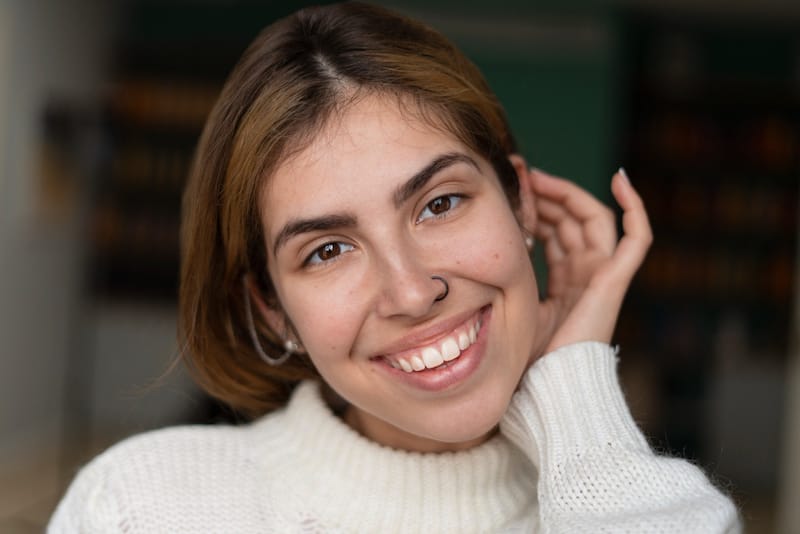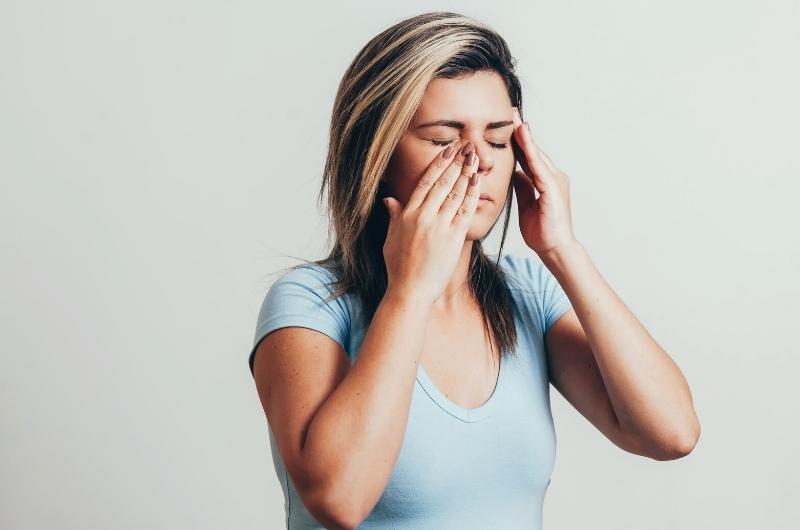Bumps naturally grow due to the wound made by your nose piercing. It’ll heal within a few weeks or could take several months by regularly keeping the piercing site clean, applying a warm compress, and treating allergic reactions immediately. Medical treatments like applying calamine lotion, corticosteroid creams, or laser treatment may be necessary for bumps that don’t heal.
Nose piercings have been trendy these days. Some people may find them attractive, while others may negatively interpret them.
But, did you know that in most parts of the world, nose piercings symbolize culture, traditional beliefs, and the beauty of ancient art?
Well, no matter how you see or wear nose piercings, for fashion purposes or as the symbol of your coming-of-age years, it would call attention to everybody.
How long before my nose piercing wound heals?
Do you believe in Bob Dylan’s saying, “Behind every beautiful thing, there’s some kind of pain?”
Well, getting nose piercings is exactly like that.
I did have my ears pierced when I was young, and I remember the pain, infections, and all the swollen bumps I had to endure just so I could wear fancy, shimmering jewelry that would match my clothes.
Nose piercings will give you a few good weeks of swelling, redness, bleeding, or bruising.
Sometimes, it can take several months before your nose piercing heals completely. Trust me; I’ve been there, maybe not with nose piercings but with my earrings.
It’ll eventually heal, which will give you the following symptoms:
- Itching on your piercing site.
- White pus may ooze out from the piercing site.
- A crust that feels like a wound scab will start to form around the jewelry (which I like to scratch off but don’t do it!).
Why do I have a bump on my nose piercing?
A piercing bump is a sign of inflammation which indicates your immune system’s response to the wound created by your piercing.
Nose piercing bumps could grow because of the following:
- Your piercer used a poor piercing technique.
- Unhygienic practices like touching your nose piercing with untidy hands.
- You used the wrong cleansing solutions for your piercing wound.
- You have an allergy to the material in your jewelry
As the nose is mostly made of cartilage, piercing in this area heals slowly compared to earlobes. So, don’t freak out when bumps don’t go away quickly.
Just be patient and see if it doesn’t give you any more severe symptoms.
6 at-home treatments for piercing bumps
Treating your piercing bumps may be tricky, and if, in any case, it’s been infected, please check with your piercer immediately.
Otherwise, if the piercing site is getting better, just that the bump is still there, you may follow these tips below:
1. Choose nickel-free jewelry

Most people are allergic to nickel. It’s one of the most common components in jewelry making.
When you’re allergic to nickel, wearing nose piercings made of it may cause you to develop symptoms like skin rash and bumps, intense itching, redness, blisters, and dried patches of skin.
It’s probably a wise choice to wear hypoallergenic piercings or studs.
You may want to consider using jewelry made of 18 or 24-karat gold, stainless steel, titanium, and niobium, and avoid those with nickel.
Just a friendly reminder, don’t take out or change your nose piercing that’s less than six months old on your own. Instead, seek help from your piercer or a professional.
2. Clean your nose piercing 2-3 times a day
Always clean your nose piercing 2-3 times a day with clean hands, especially when you just had it for around six months old.
Your piercer may recommend avoiding cleaning solutions containing triclosan and products like Betadine, Hibiclens, isopropyl alcohol, and hydrogen peroxide.
Don’t forget to tap on the inside of your nose using a clean tissue or Qtip. It will stimulate healing on that part too.
3. Do not pick any crust formed on your nose piercing
Don’t be like me, who enjoys doing that. Picking the crust on my piercing bump worsened and healed slower than before.
Also, please don’t put any ointment on the piercing site unless your piercer recommends such a product.
Also, avoid moving or spinning your piercing when it’s dry.
4. Use a sea salt solution
Add a 1/4 teaspoon of non-iodized sea salt to 8 ounces of warm water to make a sea salt solution.
If your piercer hasn’t recommended any soap to clean your nose piercing with, this is a good substitute. Make sure to do this 2-3 times a day.
You need to soak a paper towel in the solution, place it over your nose piercing for 5-10 minutes and reapply another soaked paper towel every 2 minutes to keep the area warm.
The warm compress will soften the crust or dried discharge on your nose piercing.
Dip a clean cotton bud into the sea salt solution to remove the softened crust. And then, soak another paper towel in the solution and squeeze it over your nose piercing to clean the area.
Lastly, gently pat the area to dry.
5. Try chamomile compress
Firstly, don’t do this if you have a ragweed allergy!
You can alternate cleaning your nose piercing with sea salt solution and chamomile compress.
Chamomile has excellent wound healing properties and can quickly restore your damaged skin.
Just like preparing a chamomile tea, soak a chamomile tea bag in a cup of hot water for about 3-5 minutes or until the water becomes warm.
Soak a paper towel in the solution and place it over your nose piercing for 5-10 minutes. Then, soak another paper towel in the solution and reapply every 2 minutes to retain warmth.
6. Apply diluted tea tree oil
Dilute 2-4 drops of tea tree oil to 12 drops of carrier oil like olive oil, coconut oil, or almond oil.
Make sure to do a patch test first on your skin before applying to an open wound.
To do a patch test, apply a small amount of tea tree solution to your forearm and wait 24 hours. You can apply the diluted tea tree solution to your nose piercing if you don’t see any reaction like skin irritations and inflammation.
Tea tree oil will help hydrate your nose-piercing bump, boost the healing process, fight infection and reduce inflammation.
Why does my nose-piercing bump keeps coming back?
A small bump that grows bigger, changes to an unlikely appearance, and doesn’t seem to go away could be a sign of an:
Infection
An infected nose piercing bump may give you intense pain, throbbing, and burning sensation on the pierced area.
The skin around that area may also become tender to touch, and you’ll notice green or yellowish discharge with an unpleasant odor oozing out from the piercing site.
If you experience these symptoms, don’t remove the jewelry on your own. Instead, it would be best if you visited your piercer, and they will give you advice and recommendations on how to treat your infected nose piercing.
Some infections do clear up on their own, but if the bump doesn’t seem to go away, it could be one of the following:
1. Pustule
Pustules are a bump that grows on the piercing site or next to it and looks like a pimple that contains pus.
You can treat pustules with regular cleansing using products recommended by your piercer and apply warm compresses using saline and/or chamomile solution.
Over-the-counter creams may also help unless prohibited by your piercer, such as calamine lotion, cortisone cream, salicylic acid, and benzoyl peroxide gel.
You may visit your doctor to get your bump lanced if home treatment doesn’t work.
2. Granuloma
It’s a hard lump or blister, often reddish, formed by the growth of extra skin tissue on or next to the piercing site.
Granulomas tend to bleed easily, can become infected, and form crusted sores. So, you shouldn’t pick a granuloma as it can easily cause an infection.
Granulomas may occur six weeks after your piercing.
Home remedies may include drinking Vitamin E supplements to support faster healing and using corticosteroid cream. But, if both don’t clear up the granuloma for a few days, you must seek medical treatment.
Your doctor may need to remove the granuloma using liquid nitrogen or silver nitrate.
3. Keloid
Unlike a regular small-sized nose piercing bump, keloids can grow bigger within weeks or after several months around the piercing site or beyond it.
They can cause scarring after your wound has healed.
Keloids are also very itchy and typically grow into a big-sized bump making the nose piercing area hard to move.
Keloids usually occur 3-12 months after your piercing.
Your doctor may put you on corticosteroids or laser treatment to shrink your keloid.
Cryotherapy is also possible if you have smaller-sized keloids and lighter skin. However, people with darker skin aren’t recommended to get this treatment as it may cause pigmentation.
Surgery for keloid removal may be optional but isn’t necessary as your keloid may go back and grow in size.
How to prevent nose piercing bumps?
When you get a nose piercing, expect bumps to grow. But you can, however, take the following preventive measures to prevent them from growing and getting infected:
- Don’t pierce your nose or any part of your body by yourself. Instead, ask for a service from a reputable salon with good piercing techniques, proper hygiene, and sterilized equipment.
- Choose nickel-free jewelry such as nose studs and rings made from gold, stainless steel, titanium, or niobium.
- Clean the nose piercing 2-3 times a day as directed by your piercer and avoid products and solutions that will be prohibited.
- Don’t play or move your piercings, especially when they’re less than six months old, as they can irritate and interrupts your healing.
- Don’t remove nor replace the jewelry until the hole has healed completely or unless your piercer does the job.
- Avoid picking scabs or crust and popping your piercing bumps.
- Always keep your hands clean before touching your nose piercing.
- Avoid public water places like pools, lakes, or rivers.
- Don’t put ointments not recommended by your piercer.
Conclusion
Don’t panic when bumps grow after getting a nose piercing. They’re only natural.
But, it would be best if you took preventive measures to reduce your risk of infection.
These include choosing a reputable and hygienic piercing salon, cleaning your piercing regularly, choosing nickel-free jewelry, keeping the jewelry in place, and not picking the crust or bumps that have grown on your piercing wound.
Always seek medical help immediately when home treatments don’t improve the healing process of your piercing bumps.


